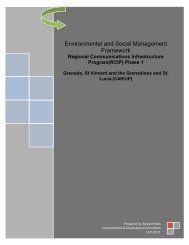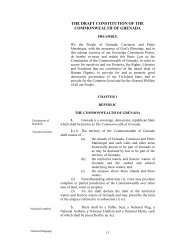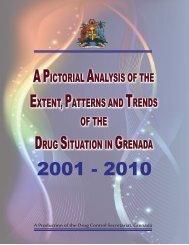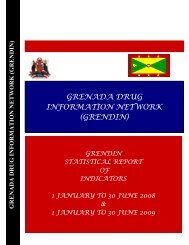The link between drug use and HIV/AIDS among young people in ...
The link between drug use and HIV/AIDS among young people in ...
The link between drug use and HIV/AIDS among young people in ...
You also want an ePaper? Increase the reach of your titles
YUMPU automatically turns print PDFs into web optimized ePapers that Google loves.
Impact of prevention strategies<br />
In school females 14-16 years reported that the exist<strong>in</strong>g prevention <strong>and</strong> <strong>in</strong>tervention programmes were<br />
a bit <strong>in</strong>fluential <strong>and</strong> helped <strong>young</strong> <strong>people</strong>. Some who had participated <strong>in</strong> some programmes stated that<br />
the programmes had benefited them but some were not aware of the impact on other youth. <strong>The</strong>y<br />
appeared well <strong>in</strong>formed of <strong>in</strong>tervention programmes, had participated <strong>in</strong> a few <strong>and</strong> stated that the<br />
programmes were effective.<br />
It appeared that <strong>in</strong> school males, <strong>and</strong> out of school males <strong>and</strong> females did not know much about<br />
current <strong>in</strong>tervention programmes on <strong>drug</strong> <strong>use</strong> <strong>and</strong> <strong>HIV</strong>/<strong>AIDS</strong>. Only about two out of school females<br />
14-16 years appeared to have participated <strong>in</strong> or attended just about two programmes, which they<br />
reported were good but <strong>in</strong>effective.<br />
“It was very good but that d<strong>in</strong> mean noth<strong>in</strong>g, but that d<strong>in</strong> mean noth<strong>in</strong>g. Like it come <strong>in</strong><br />
here <strong>and</strong> it pass out here. <strong>The</strong>y have to do someth<strong>in</strong>g better.” [females, 14-16, out of<br />
school]<br />
<strong>The</strong> mixed group of <strong>in</strong> school participants 17-19 years <strong>in</strong>dicated that the radio <strong>and</strong> television messages<br />
were not attractive <strong>and</strong> thus did not hold youth’s attention.<br />
One group criticized the abst<strong>in</strong>ence efforts targeted at youth, <strong>in</strong>dicat<strong>in</strong>g that it was difficult for youth<br />
to absta<strong>in</strong>.<br />
“Beca<strong>use</strong> you feel like the world go<strong>in</strong>g <strong>and</strong> leave you <strong>and</strong> everybody hav<strong>in</strong>g sex … <strong>and</strong><br />
everybody hav<strong>in</strong>g fun … <strong>and</strong> you just dere as a stupid .. so time, you time will never come.<br />
Beca<strong>use</strong> you start to do it already, you get addicted to it <strong>and</strong> so you can’t stop.” [females,<br />
14-16, out of school]<br />
<strong>The</strong> two groups 20-24 years, particularly the out of school mixed group seemed to know very little<br />
about prevention strategies, <strong>and</strong> <strong>in</strong> fact reported that there were none with<strong>in</strong> their communities. After<br />
briefly identify<strong>in</strong>g only two programmes, the <strong>in</strong> school mixed group reported that these programmes<br />
were not too effective.<br />
What can be done?<br />
Participants were very vocal <strong>in</strong> identify<strong>in</strong>g what <strong>in</strong>tervention strategies need to be implemented <strong>in</strong><br />
order to curtail the negative activities of <strong>young</strong> <strong>people</strong>. <strong>The</strong> major po<strong>in</strong>ts identified by participants to<br />
ensure the effectiveness of <strong>in</strong>tervention <strong>and</strong> prevention programmes were that programmes needed to<br />
be cont<strong>in</strong>uous, allow<strong>in</strong>g youth to hear the messages frequently to have an impact <strong>and</strong> that <strong>young</strong><br />
<strong>people</strong> needed to know they can trust those implement<strong>in</strong>g the programmes to be there for them at all<br />
times.<br />
Six groups asserted that it was essential for parents to be more <strong>in</strong>volved <strong>in</strong> prevention <strong>and</strong> <strong>in</strong>tervention<br />
programmes <strong>in</strong> order to redirect the youth to positive attitudes. Further, parents needed to foster better<br />
relationships with their children to elim<strong>in</strong>ate the fear that <strong>young</strong> persons face <strong>in</strong> talk<strong>in</strong>g with their<br />
parents about <strong>drug</strong>s <strong>and</strong> sex. It was important to youth to have adults set the example <strong>and</strong> be positive<br />
role models for <strong>young</strong> persons.<br />
Five groups reported that there was a dire need to change the poor socio-economic situations of<br />
persons <strong>in</strong> order to atta<strong>in</strong> positive behavior. Provision of hous<strong>in</strong>g, employment, skills tra<strong>in</strong><strong>in</strong>g <strong>and</strong><br />
education for the poor, as well as the build<strong>in</strong>g of community centers <strong>and</strong> sports facilities <strong>in</strong><br />
communities as after-school activities <strong>and</strong> to occupy unattached youth were also identified as<br />
appropriate measures for the prevention of risky behavior <strong>among</strong> youth.<br />
37

















